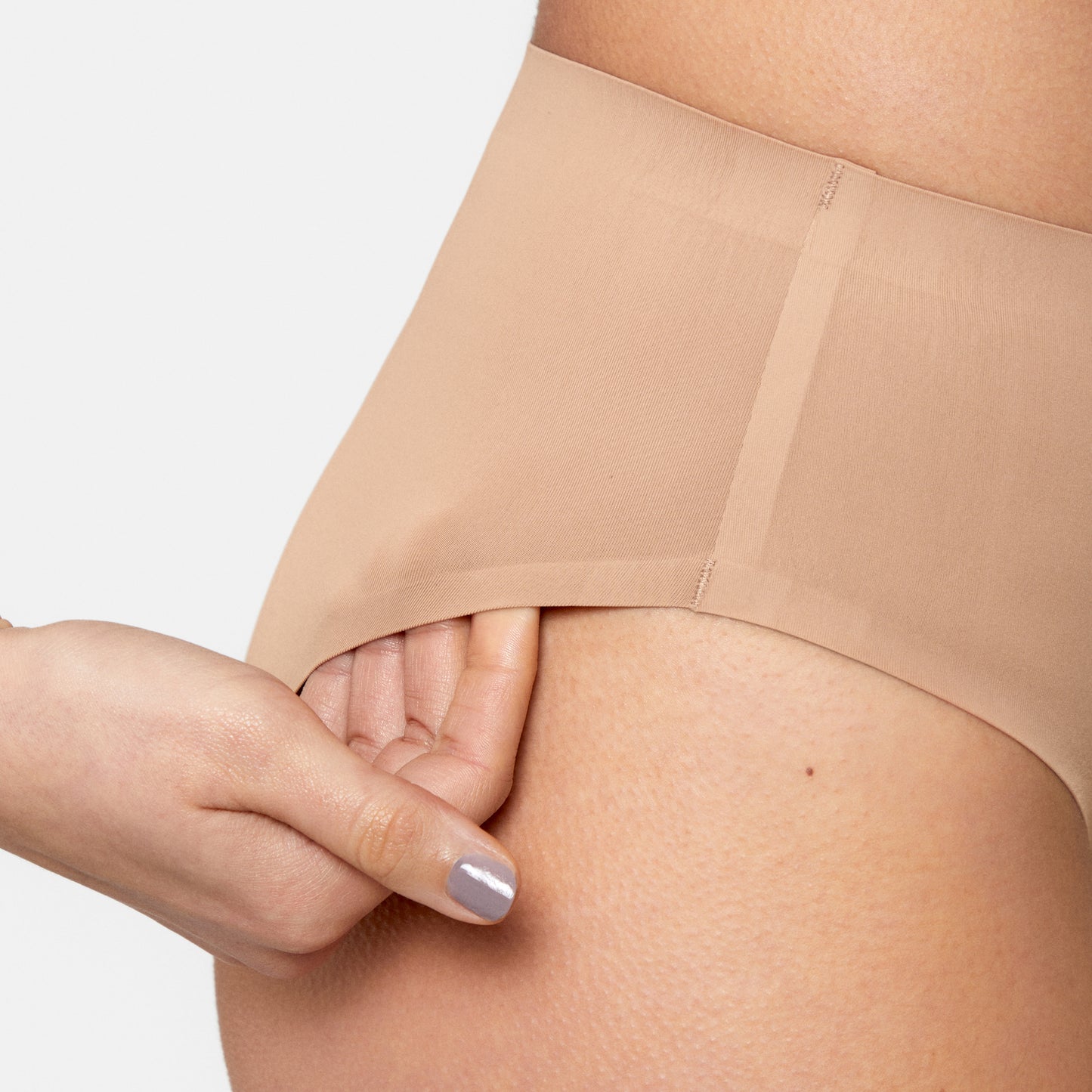Endometriosis: Symptoms, Diagnosis & Treatment
A finely tuned interplay of organs and messenger substances ensures that your cycle can proceed undisturbed every month. But what happens when cells from the uterine lining, or cells that resemble those of the uterine lining, wander to places where they don't belong? That's the case with endometriosis. Have you never heard of this condition before? You're not alone. Here's how you can find out if you're affected.
What is Endometriosis?
The uterus is lined with a mucous membrane called the endometrium. This is where the fertilized egg implants during pregnancy. In the regular menstrual cycle, the body sheds the uterine lining cells with menstrual bleeding. Many women also have herds of these cells outside the uterus.
Typical locations include:
- the peritoneum in the pelvis,
- the ovaries,
- the outer wall of the uterus,
- the bladder, and
- the intestines.
In theory, these small benign growths can settle throughout the entire body. They vary in size and grow under the influence of your sex hormones, just like the uterine lining. When you have your period, the endometriosis lesions also bleed. If the blood irritates your peritoneum, you may experience pain in your back or abdomen. Sometimes cysts form because the blood has no place to drain.
What are the causes and risk factors?
The causes of endometriosis are not yet known. There are various theories attempting to explain its development. However, none of these theories have been scientifically proven, so there is currently no treatment.
Prevalence of Endometriosis
Endometriosis is not a matter of age. Adolescents can already experience disease symptoms from their first menstruation. The highest likelihood of developing endometriosis occurs between the ages of 35 and 45. Estimates from experts on its occurrence range between 8 and 15 percent of all women between puberty and menopause. That's up to 40,000 new cases per year in Germany. Which makes endometriosis the second most common gynecological condition.
Symptoms: How do I determine if I have endometriosis?
The condition occurs during a woman's fertile years as it is closely related to the effects of sex hormones. The symptoms typically subside after menopause. Do you experience severe pain during your periods? Many women simply consider it normal. However, it could be caused by endometriosis. Endometriosis can also manifest outside of the menstrual period in the menstrual cycle; for example, you may suffer from extremely severe PMS. The risk is particularly high if you had an early onset of your first menstrual bleeding and if your cycle length is short.
Possible symptoms include:
- severe abdominal or back pain during menstruation
- lower abdominal pain in the second half of the menstrual cycle
- heavy menstrual bleeding
- spotting between periods
- pain during or after sexual intercourse
- discomfort during routine gynecological examinations
- pain during urination
- digestive issues such as diarrhea or constipation
- blood in urine or stool
However, it is also common for affected women to have no symptoms at all and only become concerned when they experience difficulty conceiving.
Many women report that the right choice of period products makes a huge difference to their pain. For many, period underwear is a total game changer during menstruation: nothing to insert, just put it on and feel comfortable! High-waist models are especially popular with endometriosis sufferers because they flatter the belly and nothing pinches or squeezes.
Diagnosing Endometriosis
Do you suspect that you might have endometriosis? You can assist your gynecologist in the diagnostic process by keeping a pain diary and recording your menstrual cycle. Your doctor will ask you detailed questions about your symptoms and then conduct a gynecological examination. If there is a suspicion of endometriosis, the rectum is usually palpated as well. This can be slightly uncomfortable but is important. An ultrasound examination may be the next step. You can directly see large endometriotic lesions on the screen.
Have you heard of adenomyosis in relation to endometriosis? Adenomyosis is a gynecological condition that has long been considered a subtype of endometriosis. It is characterized by the invasion of endometrium-like tissue into the uterine muscle. Approximately 50 percent of all patients with adenomyosis also have endometriosis.
Laparoscopy (abdominal inspection) is the most reliable diagnostic method. You will be asleep during the minor surgical procedure. The doctor inserts a camera and instruments into your abdomen through tiny incisions. This allows the endometrial lesions to be detected, examined, and removed simultaneously. If you are having trouble conceiving, the medical professional will also examine your ovaries and fallopian tubes. An ultrasound or MRI examination is usually insufficient as endometrial lesions are often not visible, but this does not mean that endometriosis is not present. Laparoscopy remains the most reliable method for detecting endometriosis.
Treatment for Endometriosis: Available Options
Scientists are still searching for the exact cause of the condition. There are theories suggesting that endometrial lesions develop during human development or that endometrial cells are sucked into the abdominal cavity from the uterus through the fallopian tubes during the female menstrual cycle. A genetic component is also discussed as a possible cause. Currently, endometriosis is not curable. The treatment options are as diverse as the patients. Depending on your symptoms, you may find the best care with a gynecologist, a pain therapist, a psychologist, or a holistic practitioner.
Common Treatment Methods
There are various approaches to treatment methods that you can discuss with your doctor. These can include:
- Laparoscopy (abdominal inspection) with surgical removal of the lesions
- Pain management with medication (Ibuprofen, Diclofenac, etc.)
- Hormone therapy to prevent the stimulation of endometrial cells
- Complementary therapy with acupuncture or traditional Chinese medicine
- Homeopathy or herbal medicine
In hormone therapy, you can be treated with GnRH agonists. These reduce estrogen production, suppressing the growth of endometriotic lesions. However, it should be noted that long-term use of GnRH agonists for more than 4 to 6 months leads to decreased bone density and can cause osteoporosis. To minimize the decrease in bone density, doctors may administer small amounts of progestin or bisphosphonate preparations to women.
The right endometriosis treatment for you can only be decided in consultation with your doctor. It depends on whether you want to become pregnant, your age, and the symptoms you experience.
3 Tips for Endometriosis Pain
There is currently no cure for the disease in which endometrial cells implant in other parts of the body. However, there are several things that can make life with the diagnosis of 'endometriosis' easier for you and help with endometriosis pain.
To explain briefly: In individuals with endometriosis, cells from the uterine lining grow in locations outside the uterus, causing pain. Endometriotic lesions are often found in the lower abdomen or pelvic area, on the ovaries, in the fallopian tubes, in deeper layers of the uterine walls, and on or in the intestines. In principle, endometrium-like tissue can grow anywhere in the body.
Knowledge is Power
In addition to medical visits and discussions with experts, we recommend conducting a hormone test independently. It will show you where your body and hormone levels are deficient. Afterwards, you can discuss the test results with a trained advisor.
Heat for Endometriosis
On some days, the pain is unbearable without medication. Heat is particularly helpful, so a hot water bottle or cherry stone pillow should be a staple for you. With our warming period panty SOFI, you can carry your heating pads with you directly in the panty. It's your portable warmth on the go. Discover our underwear for endometriosis.
Choosing the Right Menstrual Products
Whether it's light spotting during ovulation or heavy bleeding in the first days of your period - stay away from tampons! They only exert more pressure and further dry out the vaginal flora. We recommend our period panty JULE for heavy flow days. It's super comfortable and can hold as much blood as three tampons. In the ULTRA version, it can absorb as much as 9 tampons' worth of fluid. Our SOFI panty is your perfect companion with integrated pockets for our fempads.
Living with Endometriosis
According to estimates, about 40,000 women in Germany are diagnosed with endometriosis each year. This means that 1 in 10 women suffers from endometriosis! Nevertheless, almost no one talks about this topic. We want to contribute to making endometriosis a more frequently discussed subject and ensure that no affected individual feels alone anymore! Additionally, it is important to connect with other women who share the same experiences, as it can provide support on the mental and emotional level as an endometriosis patient. Many affected individuals share their experiences with the disease on social media and engage in platforms like Instagram.
Many of our customers are affected by endometriosis, and the experiences they share with us continually touch us. We regularly receive messages stating that many affected individuals have finally found a comfortable menstrual product with our period underwear, which eases their daily life and helps them manage endometriosis pain. Let's strengthen awareness for endometriosis together and fight against the disease.
Sources:
- Uhl, Bernhard; Gynäkologie und Geburtshilfe compact: Alles für Station, Praxis und Facharztprüfung; Thieme Verlag; Stuttgart, 2017
- Kleen, Heike; Das Tage-Buch: Die Menstruation – alles über ein unterschätztes Phänomen; Wilhelm Heyne Verlag; München, 2017
- Feige, Gerhard; Geburtshilfe integrativ: Konventionelle und komplementäre Therapie; Urban und Fischer Verlag; München, 2005
- https://www.who.int/news-room/fact-sheets/detail/endometriosis


